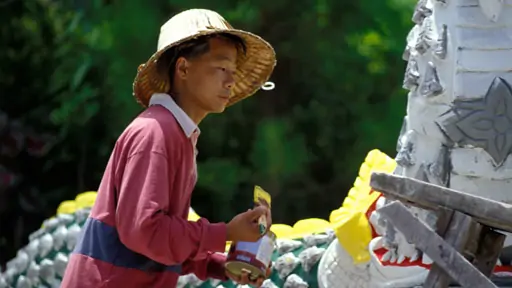Indigenous Calendar May, 2011: Preserving Shan Culture and Serenity in Thailand

People all over the world migrate across international borders and for many different reasons. In the case of the Shan people of Burma (Myanmar), it is primarily because of decades of conflict and civil war with that country's military government. While reliable statistics are not available, the number of Shan who have migrated from Burma to Thailand in the past thirty years is easily in the tens of thousands — perhaps in the hundreds of thousands or millions.
Although they are political asylum seekers, few of the Shan who cross the border are recognized as such and given legal refugee status in Thailand. This is one reason why they have to take the lowest-paid, wage labor jobs — often in the fishing and construction industries.
Knowing this background before I first visited northern Thailand, I knew I would meet Shan people while traveling there. They were not the focus of my work since I was sure I would later visit Burma and meet many more Shan people there. Yet as I traveled around and heard more first-hand accounts of their recent history and struggle I began to pay more attention to the Shan in Thailand.
While many of the Shan in Thailand are fast being culturally assimilated into Thai culture, many also regard the preservation of their own culture to be important. They continue to speak among themselves in the Shan language even while they must also learn Thai to survive. They also adhere strongly to their Theravada Buddhist religious tradition.
I had been wondering for a few days what kind of photograph might capture my observations of the Shan in northern Thailand. As often happens, my own assimilation of my thoughts had painted one of those pictures in my mind that I would know when I saw it.
On this day I saw it. In a predominantly Shan village a new temple was being built; some parts of the construction were not even dry yet. But this Shan man did not want to wait for it to dry before he began painting the left-side dragon that stood at the entrance to the temple. As I observed him before taking out my camera I could not help but notice the sheer serenity in the way he went about his painting task. This serenity was built into his mannerisms and the expression on his face — he had clearly found a peace within himself despite what he must have been through having been forced to leave his homeland.
The Shan are featured in our documentary, Indigenous Peoples of Southeast Asia.
If you enjoyed reading this article, please consider supporting independent, advertising-free journalism by buying us a coffee to help us cover the cost of hosting our web site. Please click on the link or scan the QR code. Thanks!


